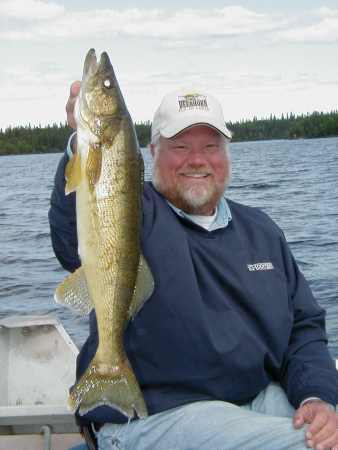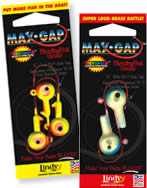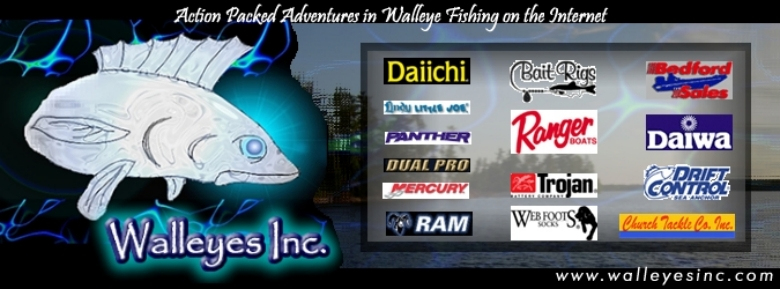|
Shortly after ice-out, male walleyes in the 1 to 3 pound
range will move into shallow spawning areas. The best spawning
sites are large sloping shallow bars with a bottom composition
of gravel. The aggressive male walleyes will hold over these
areas for a month or more and feed aggressively during, before
and after spawning. The larger walleyes are most always females,
and although they can be taken during the pre spawn period,
they are virtually impossible to take while spawning and reluctant
to bite for a two-week period following the rigors of procreation.
Although the male walleye is active and aggressive in early
spring, being a cold-blooded creature, his metabolism is determined
by water temperature. This means simply that spring walleyes
cannot chase down a fast moving bait. Slow, slower and slowest
are the three speeds for taking spring walleyes. The key to
locating walleyes in the river in the late winter and early
spring starts with locating a series of obstacles. Then, allowing
your bait or lure to present itself in a natural manner so
the walleye can race from behind the obstruction to acquire
the offering and then race back into the slack water area
to digest his meal and await another. Look for breaks in the
current. They may be behind islands, points, and below bars
in mid channel. In strong current, walleyes group tight to
structure. In softer current or low water periods, like winter,
they often scatter, and hold on edges of barriers or current
breaks. Shallow water is usually defined as any water that
you can't sit on top of with a boat, walleyes can and do inhabit
this type of water. Tradition would say that this is the area
that you will find fish in early spring, summer or fall. But,
actually it is where you will find fish all year round. Some
fish could be in 2 feet of water and others in 20 feet of
water on the same body of water at the same time of year.
All in all I have found many walleyes that are aggressive
in shallow water and I'll fish it more times than deep water.
After spawning, big females slowly drop downstream, and refurbish
for a week to ten days. Catching them during this period is
nearly impossible, but keep in mind that the fish are in the
recuperation stage at the same time. When the effects of spawning
finally wear off, big walleyes begin a feeding binge unrivaled
at any other time. Peak fishing usually begins in early May
and continues for two to three weeks. By this time, the fish
have usually moved far from the tailwaters, although a few
stragglers may remain. The areas where you'll find them now
have one thing in common - current. Look for flowing cuts
off the main channel or sandy points where current buffets
the tip. Don't bother fishing deeper than 12 feet. Untipped
jigs are still the best bet, but now live bait, especially
nightcrawlers, comes into play. My favorite technique is anchoring
and casting around the tips of sandy points. These areas often
hold numbers of good-sized walleyes and drifting takes you
through the fish zone too fast. Many of the big ones are taken
by shore fisherman who know the right spots. Fish are wary.
This helps them survive and can also make them difficult to
catch. They utilize their excellent senses of vision and hearing,
detect motion with unerring accuracy using their lateral line,
and also use their sense of smell. Therefore, a cautious approach
is required of an angler In the spring the warmest water will
be close to shore. The warmest water is where the fish will
be most active, so that's why we're fishing there. When fishing
these shallow areas, it's important that you keep motions
to a minimum. Fish in shallow water are generally spookier
than they would be in deep water. Walk softly and wear light
colored clothing. You want a jacket or a sweatshirt that blends
in with the sky. Remember, you'll be above the fish and the
sky will be the background. Dark clothing will stand out against
the light background and your movements will be easily detected
by the fish. When working shallow areas to shore, especially
when the water is clear, keep your cast parallel to the shore.
Keep the noise to a minimum by using your MinnKota trolling
motor. The most active fish will be within 10 feet off shore,
perhaps closer. If you cast the bait 30 feet out from the
shore and retrieve it, the lure is in the most productive
zone for only the last 10 feet of the cast. If you cast the
bait parallel to the shore and retrieve it, it's in the fish
zone all the time.
 |
This technique is very productive even later on in the
summer when fishing for largemouth bass and panfish. With
either natural bait or artificial lures, the presentation
must be realistic. It should appear that the offering
is part of the normal food chain. Hunger is certainly
a major motivating factor, but fish also respond as predators
and strike something that moves. At times, they even exhibit
antagonistic behavior when biting an intruder to drive
it away. The fishing technique used when fishing weeds
is very basic. The first basic method we all were exposed
to when we were young was, slip-bobber fishing. The slip-bobber
has taken more fish along a weedline than any other method.
All you have to have is a bobber, split shot, and a hook.
Attach a minnow or a crawler and sit back and wait for
the fish to come to you. Another basic way is the use
of the cast retrieve method with one of my favorite lures,
the spinnerbait. I prefer to use the Big-Fin spinnerbaits
from Lindy Tackle or I might flip a Techni-Glo Skeleton
Shad Spadetail into the thick matte of cover. |
My all time favorite way to get the big fish out of the vegetation
is to use a jig, not just any jig, but a heavy-duty jig. Sometimes
you might see this referred to as a pig'n jig. With the jig
I can maintain a quiet presentation. A quiet presentation
of the lure also increases your ability to catch fish. As
soon as the lure enters the water, swim it back through the
cover. Swim the lure fast enough to keep it from sinking,
and pump the rod every few seconds to create lure action.
Eager fish holding in the cover will run right out of the
biggest clump of weeds to chase the jig.
 |
Walleyes will be along the riprap banks and rocky shorelines
in the spring because they slide in behind the rocks and
riprap to avoid current conditions and as a staging place
for ambushing their next meal. In dirty or stained water
it's possible to dabble a jig tipped with a minnow or
redtail chub on a long rod. Just lift and drop the Lindy
Max Gap jig around rocks and anything else that breaks
the current. Locating fish is easy, just look for structure
such as weeds or current breaks and remember the predator
prey relationship and you will catch more fish this spring.
Drop me a line on the web at www.walleye.info for more
information about getting a few walleyes this spring.
|
|

